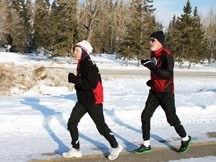If you want to learn how to do things correctly, you might as well learn from someone who wrote the book on the subject.
I have ran for years with various degrees of success, ranging from the Sheep River Road Race to finishing woefully behind Okotoks’ Lori Toombs at the Winnipeg Marathon a few years back.
However, I’m not getting any younger. So I opted to get some advice from someone who sprinted into her golden years — former Millarville resident Helly Visser.
Visser is a member of the Canadian Masters Hall of Fame and has set many age-category running records.
The 76-year-old Visser and fellow runner Roger Davies have written “Guide to Natural Posture Running — A Whole Body Involvement”.
Natural posture running was something the authors delved into after going to a seminar by the now-semi-famous Dr. Dan Lieberman in Calgary.
“I was a traditional runner, pounding my heels,” said Visser. “It wasn’t until after we went to his clinic and really delving into his research that we began natural posture running.”
Leiberman, known as the “The Barefoot Professor”, was featured prominently in Christopher McDougall’s 2009 bestseller “Born to Run”, a must read for any running enthusiast and just a great read for anyone.
Visser and Davies began giving natural posture running (NPR) clinics in 2005.
The 75-year-old Davies said he has run virtually injury-free since using NPR. He has won medals at the World Master Athletics in 2001, 2005 and 2010. He was named Outstanding Master Athlete of the Year by Athletics Alberta in 2001 and 2005.
“When I started using natural posture running my efficiency went through the roof,” Davies said. “I’m aware of what my arms, my head and my body is doing.”
NPR isn’t complicated, it’s practically child’s play.
“If you watch children run, their heads are up, they just lean and go,” Davies said. “They are like a rabbit going across a field. They haven’t developed the bad habits yet.”
Their NPR philosophy is based on posture and gravity. There is a slight lean at the ankles, not the waist, to propel the runner forward. The body from the foot to the head is in a straight line.
Runners are also encouraged to use a shorter running stride. The foot strikes the ground on the balls of the foot or a mid-foot landing.
You don’t strike heel first, a common habit thanks to the development of running shoes since the mid-1970s, which had shoes with plenty of foot padding.
On Dec. 9 at Fish Creek Park in Calgary Davies was using a minimalist shoe — one with little padding to quasi-simulate barefoot running. The theory being runners have become too dependent on heavy-soled shoes with plenty of support.
As a result, runners are not building up key muscles in the foot and calves.
I’m also running in minimalist shoes, which means I forked over about $120 for a running shoe with a cool swoosh on it, that is more or less like those $7 Keds you bought years ago.
It was time to head out. We ran for about a kilometre at which point Davies and Visser critiqued my style.
Turns out I’m pretty good, actually.
The biggest problem is my arms. I have a tendency to let my arms dangle, with a slight bend at waist level. My thinking is don’t do anything with your arms so I can save my energy for my legs.
Wrong.
Visser grabs my arms and bends them at about 45 degrees (fortunately she bends them forwards, not back).
She tells me to keep my arms relaxed and to think there is a pin at my shoulder from which my bent arms will swing. I shouldn’t be swinging my arms across my chest like a boxer, but instead straight ahead.
She also encourages me to relax. She recommended I try running with a cracker between my thumb and my clenched other fingers. If I break the cracker it means I am too tense.
It turns out I have a lazy right foot, it points slightly to the outside when I run. This surprises me because I injured my right foot falling off a stationary bus (young, stupid male, ski trip).
Visser has me run the kilometre trying to straddle the yellow line on the pathway system. I tried it, but it left me thinking I sure hope I never have to take one of those old-fashioned sobriety tests because I couldn’t keep a straight line. As well my right foot was pointed in more directions than Brienne Jamieson’s baton when she is conducting the John Paul II Collegiate band last week.
Still, Davies said I was pretty good.
The next step – several steep steps – was to run up one of the Fish Creek hills. Though not as tough as Okotoks’ 32nd Street or Centre Avenue hills, still pretty tough.
I was told to look straight ahead, not at the ground and to shorten my stride.
Visser and I headed up, and I was the first to the top.
Davies commented I was a good at running hills. I had to admit I’m not that good, just a tender male ego.
“There was no way I was going to let a 76-year-old lady beat me up the hill,” I confessed.
The mini-workshop was useful and I hope I can use some of the techniques in the future.
Their book also comes with diagrams of stretches and exercises to benefit runners.
To purchase “Guide to Natural Posture Running” go to www.nprunning.com. They are also available at Gord’s Running Store in Calgary. Their next NPR clinic is in March.




